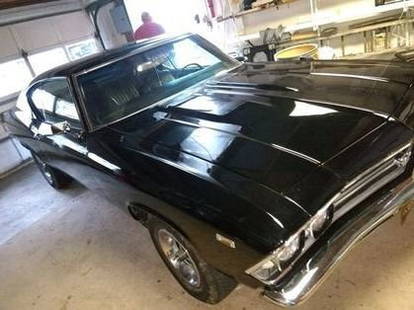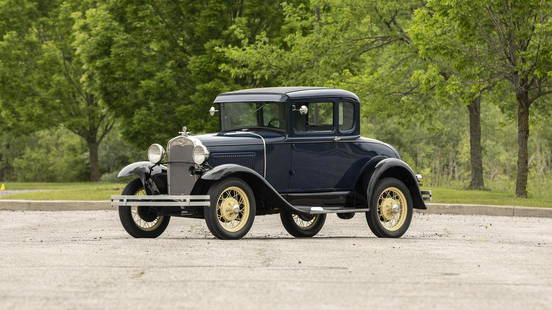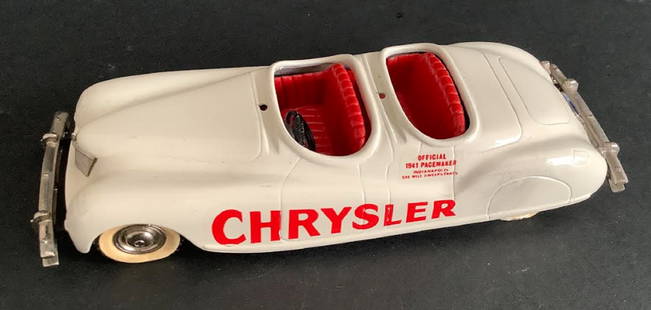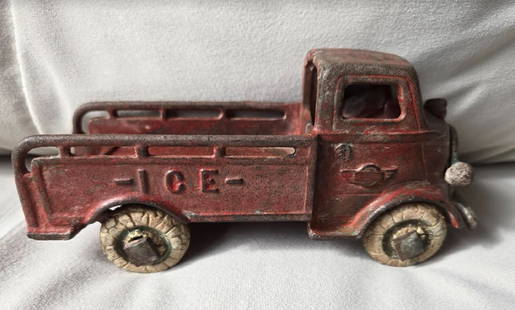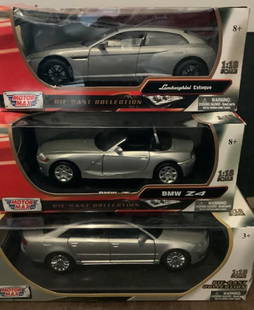
1953 Ferrari 212 Inter Coupe
Similar Sale History
View More Items in Cars

Related Cars
More Items in Cars
View MoreRecommended Cars & Motors
View More











Item Details
Description
Chassis #: 0267 EU
150 hp, 2,562 cc SOHC V-12 engine, three Weber 32 mm DCF carburetors, five-speed manual transmission, independent front suspension by double wishbone and transverse leaf spring, rear live axle with semi-elliptic leaf springs and trailing arms, four-wheel hydraulic drum brakes. Wheelbase: 102.4"
- Owned by Ferrari enthusiast and FCA co-founder Larry Nicklin for over three decades
- A matching-numbers example
- Shown at 35th Turin Motor Show in 1953
- One of 80 212 Inter Ferraris
- Documented by Ferrari historian Marcel Massini
Produced between 1951 and 1953, Ferrari’s 212 series carried the latest evolution of the formidable Colombo V-12. It was immediately successful in competition, winning both the Tour of Sicily and the Coppa Inter Europa. Gianni Marzotto won the Coppa Toscana, but the most important victory was surely the 1951 Carrera Panamericana, wherein Luigi Chinetti and Piero Taruffi came in first, followed by Alberto Ascari and Luigi Villoresi – an amazing one-two finish for Ferrari!
As was common Ferrari practice, even-number chassis were applied to competition cars while odd numbers were road cars – or Inters. However, the degree of individual orders meant that Inters could have different performance features, and this particular car is currently fitted with the triple Weber carburetor setup, which boosts performance by 30 horsepower and pushes top speed to around 125 mph.
Eighty open and closed 212 Inters were built, making it the most prolific model to use the original Colombo-designed V-12 engine. And despite the number of 212s sold, almost all have detail differences, as they were individually custom-bodied by various coachbuilders.
These Berlinetta coupes and open two-seater Barchettas, with their lightweight V-12 engines and tube frames and aluminum panel “superleggera” construction, would set the Ferrari pattern for the next decade.
Vignale
All told, the 80 units of the Ferrari 212 Inter built in all body styles ranged in serial number from 0111 to 0291. Of those 80, it is believed 17 were bodied by Ghia and the same number by Pinin Farina, for a total of 34. The remaining 46 were bodied by other coachbuilders such as Touring, Vignale and others, including the Swiss firm Ghia-Aigle.
The difficulty in specificity is attributed to the fact that a number of 212s were re-bodied and several were upgraded to 225 specification with a larger engine. It is therefore rather difficult to know precisely how many 212 Inters were bodied by Vignale.
That said, the Vignale-bodied cars are particularly attractive and unique. Most early Ferrari road cars were bodied by Touring. However, by 1953 Vignale had essentially replaced them as the carrozzeria of choice, due in large part to the successful relationship between Alfredo Vignale and his young star designer Giovanni Michelotti. Together they gave Ferrari a more aggressive and distinctive look than either Touring or Ghia. Vignale liked to describe himself as an artist in metal. For him each new Ferrari chassis was analogous to the sculptor’s block of marble, a new challenge to his ability to give concrete form to his flights of fancy.
Over the years, Vignale carried a number of distinctive design features – everything from rear fins, triangular cutaways on the rear wings, slotted taillights, fender portholes, unique interiors and distinctive front-end treatments. No two Vignale Ferraris were styled exactly alike.
Chassis no. 0267 EU
The remarkable 212 Inter we have the pleasure of presenting at Amelia Island, chassis 0267 EU, was exhibited new at the 1953 Turin Motor Show, held in Parco Valentino, and is pictured on page 153 of Marcel Massini’s book Ferrari by Vignale. Fitted with air intakes below the headlamps, it is a particularly striking design, from the Vignale-designed front end, over the low roof treatment and down to the subtle fins on the rear wings.
It was sold the same year to Jean-Louis Lafourcade in Bayonne in Southwest France and registered 343 AP 64, in the French Department Les Pyrenees-Atlantique, close to the Spanish border. It was subsequently re-registered as 8686 CC 59 in the Nord Department on the Belgian border and exhibited at the Enghien Concours d’Elegance just north of Paris, also in 1953.
The car is known to have been exported to England in 1959 and sold to a Mr. Simmons in the ritzy central London district of Mayfair. In 1960, 0267 EU was pictured on page 52 of Hans Tanner’s first Ferrari Owner’s Handbook, published by Floyd Clymer in Los Angeles, but incorrectly captioned as a 250 Europa.
Although he offered the car for sale at one point, Simmons retained the car until 1969. At that point, it was bought by Peter H. Gibson at Lenk Farm, Inkberrow, Worcestershire.
Gibson ultimately sold 0267 EU in 1972 to David Shute, who lived in Kingston St. Mary, just north of Taunton, the county seat of Somerset. Shute transferred his license plates 111 FLB to the car at that time, and in 1974 he had the car repainted red and the bumpers removed. By 1976, he consigned the car to the Christie’s sale held in Geneva with the motor show.
A little more than a year later in December 1977, 0267 EU was acquired by Larry Nicklin, from whom it is offered today. A short biography of Mr. Nicklin is printed on the preceding pages. A founding member of the Ferrari Club of America, his career and penchant for strong design clearly influenced his attraction to this car. In 1979 he repainted it in its original black with a green top. It has remained in Larry Nicklin’s possession for over 30 years, until this day.
An unrepeatable opportunity
One of the most significant advantages of early Ferraris these days is the events for which the owner is eligible. Even-numbered cars with competition history will get the owner invited to a plethora of vintage rallies, concours events and historic races, but many of the odd-numbered cars were raced competitively as well, so the door is wide open. Add to this the fact that all of these cars have detail differences, which makes them attractive to historians, and the new owner will have a multitude of choices as to how to spend their summer weekends.
Furthermore, it is often repeated but entirely accurate that a classic car is only original once. More and more, Ferrari enthusiasts are attracted to highly original cars because of the restoration or preservation opportunities they present. As such, 0267 EU could either be left entirely as is, sympathetically restored and mechanically sorted or taken down to its chassis and completely restored, in which case the fact that the new owner has an extremely original car from which to start is very appealing.
Add to that the fact that 0267 EU is a matching-numbers car of a very desirable early Ferrari model, bodied by Vignale, no less. It is guaranteed to garner tremendous attention from Ferrari enthusiasts the world over, and as such we encourage very close examination.
150 hp, 2,562 cc SOHC V-12 engine, three Weber 32 mm DCF carburetors, five-speed manual transmission, independent front suspension by double wishbone and transverse leaf spring, rear live axle with semi-elliptic leaf springs and trailing arms, four-wheel hydraulic drum brakes. Wheelbase: 102.4"
- Owned by Ferrari enthusiast and FCA co-founder Larry Nicklin for over three decades
- A matching-numbers example
- Shown at 35th Turin Motor Show in 1953
- One of 80 212 Inter Ferraris
- Documented by Ferrari historian Marcel Massini
Produced between 1951 and 1953, Ferrari’s 212 series carried the latest evolution of the formidable Colombo V-12. It was immediately successful in competition, winning both the Tour of Sicily and the Coppa Inter Europa. Gianni Marzotto won the Coppa Toscana, but the most important victory was surely the 1951 Carrera Panamericana, wherein Luigi Chinetti and Piero Taruffi came in first, followed by Alberto Ascari and Luigi Villoresi – an amazing one-two finish for Ferrari!
As was common Ferrari practice, even-number chassis were applied to competition cars while odd numbers were road cars – or Inters. However, the degree of individual orders meant that Inters could have different performance features, and this particular car is currently fitted with the triple Weber carburetor setup, which boosts performance by 30 horsepower and pushes top speed to around 125 mph.
Eighty open and closed 212 Inters were built, making it the most prolific model to use the original Colombo-designed V-12 engine. And despite the number of 212s sold, almost all have detail differences, as they were individually custom-bodied by various coachbuilders.
These Berlinetta coupes and open two-seater Barchettas, with their lightweight V-12 engines and tube frames and aluminum panel “superleggera” construction, would set the Ferrari pattern for the next decade.
Vignale
All told, the 80 units of the Ferrari 212 Inter built in all body styles ranged in serial number from 0111 to 0291. Of those 80, it is believed 17 were bodied by Ghia and the same number by Pinin Farina, for a total of 34. The remaining 46 were bodied by other coachbuilders such as Touring, Vignale and others, including the Swiss firm Ghia-Aigle.
The difficulty in specificity is attributed to the fact that a number of 212s were re-bodied and several were upgraded to 225 specification with a larger engine. It is therefore rather difficult to know precisely how many 212 Inters were bodied by Vignale.
That said, the Vignale-bodied cars are particularly attractive and unique. Most early Ferrari road cars were bodied by Touring. However, by 1953 Vignale had essentially replaced them as the carrozzeria of choice, due in large part to the successful relationship between Alfredo Vignale and his young star designer Giovanni Michelotti. Together they gave Ferrari a more aggressive and distinctive look than either Touring or Ghia. Vignale liked to describe himself as an artist in metal. For him each new Ferrari chassis was analogous to the sculptor’s block of marble, a new challenge to his ability to give concrete form to his flights of fancy.
Over the years, Vignale carried a number of distinctive design features – everything from rear fins, triangular cutaways on the rear wings, slotted taillights, fender portholes, unique interiors and distinctive front-end treatments. No two Vignale Ferraris were styled exactly alike.
Chassis no. 0267 EU
The remarkable 212 Inter we have the pleasure of presenting at Amelia Island, chassis 0267 EU, was exhibited new at the 1953 Turin Motor Show, held in Parco Valentino, and is pictured on page 153 of Marcel Massini’s book Ferrari by Vignale. Fitted with air intakes below the headlamps, it is a particularly striking design, from the Vignale-designed front end, over the low roof treatment and down to the subtle fins on the rear wings.
It was sold the same year to Jean-Louis Lafourcade in Bayonne in Southwest France and registered 343 AP 64, in the French Department Les Pyrenees-Atlantique, close to the Spanish border. It was subsequently re-registered as 8686 CC 59 in the Nord Department on the Belgian border and exhibited at the Enghien Concours d’Elegance just north of Paris, also in 1953.
The car is known to have been exported to England in 1959 and sold to a Mr. Simmons in the ritzy central London district of Mayfair. In 1960, 0267 EU was pictured on page 52 of Hans Tanner’s first Ferrari Owner’s Handbook, published by Floyd Clymer in Los Angeles, but incorrectly captioned as a 250 Europa.
Although he offered the car for sale at one point, Simmons retained the car until 1969. At that point, it was bought by Peter H. Gibson at Lenk Farm, Inkberrow, Worcestershire.
Gibson ultimately sold 0267 EU in 1972 to David Shute, who lived in Kingston St. Mary, just north of Taunton, the county seat of Somerset. Shute transferred his license plates 111 FLB to the car at that time, and in 1974 he had the car repainted red and the bumpers removed. By 1976, he consigned the car to the Christie’s sale held in Geneva with the motor show.
A little more than a year later in December 1977, 0267 EU was acquired by Larry Nicklin, from whom it is offered today. A short biography of Mr. Nicklin is printed on the preceding pages. A founding member of the Ferrari Club of America, his career and penchant for strong design clearly influenced his attraction to this car. In 1979 he repainted it in its original black with a green top. It has remained in Larry Nicklin’s possession for over 30 years, until this day.
An unrepeatable opportunity
One of the most significant advantages of early Ferraris these days is the events for which the owner is eligible. Even-numbered cars with competition history will get the owner invited to a plethora of vintage rallies, concours events and historic races, but many of the odd-numbered cars were raced competitively as well, so the door is wide open. Add to this the fact that all of these cars have detail differences, which makes them attractive to historians, and the new owner will have a multitude of choices as to how to spend their summer weekends.
Furthermore, it is often repeated but entirely accurate that a classic car is only original once. More and more, Ferrari enthusiasts are attracted to highly original cars because of the restoration or preservation opportunities they present. As such, 0267 EU could either be left entirely as is, sympathetically restored and mechanically sorted or taken down to its chassis and completely restored, in which case the fact that the new owner has an extremely original car from which to start is very appealing.
Add to that the fact that 0267 EU is a matching-numbers car of a very desirable early Ferrari model, bodied by Vignale, no less. It is guaranteed to garner tremendous attention from Ferrari enthusiasts the world over, and as such we encourage very close examination.
Buyer's Premium
- 10%
1953 Ferrari 212 Inter Coupe
Estimate $375,000 - $550,000
1 bidder is watching this item.
Shipping & Pickup Options
Item located in Auburn, IN, usSee Policy for Shipping
Payment

TOP















